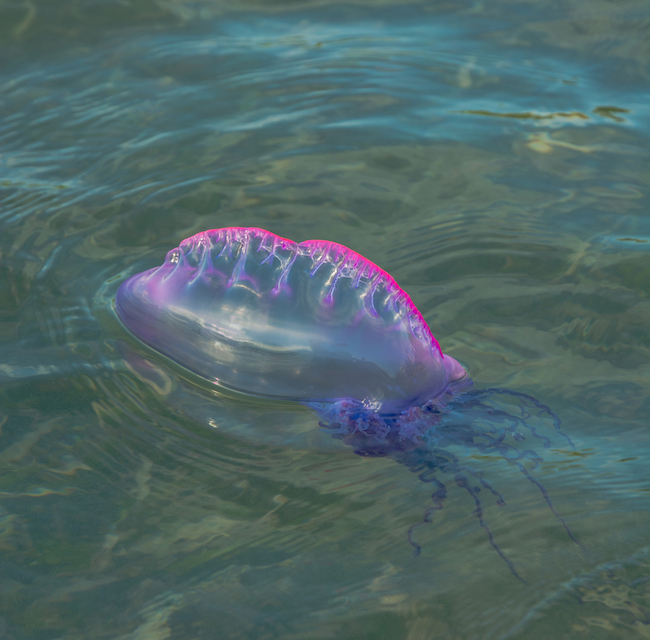Jersey Shore Situation: Man-of-War 'Jellyfish' Pays a Visit

The Jersey Shore is the place to be this summer (if you're a dead sea creature). Last week, a baby dolphin that had been torn apart by sharks washed up in Wildwood, New Jersey. And over the weekend, an even freakier critter came ashore in the Garden State — a Portuguese man-of-war "jellyfish."
The potentially deadly creature, which can deliver a paralysis-inducing sting, washed ashore at Harvey Cedars, on Long Beach Island, New Jersey, on Sunday (June 21). These animals usually float around in warm water (they're often found near Australia, as well as in the Gulf of Mexico), so it's a bit strange this lone man-of-war was lingering in the brisk 68-degree-Fahrenheit (20 degrees Celsius) waters off the Northeast United States.
While there's always a chance the man-of-war came to Jersey just to get a slice of pizza, it's more likely the deadly jellyfish creature traveled there by accident, in the Gulf Stream, a powerful current of water that moves northward along the East Coast, according to John Tiedemann, director of the Marine and Environmental Biology Policy Program at Monmouth University in New Jersey. [See Images of Amazing Jellyfish Swarms]
"It probably came up with the Gulf Stream and then we had a little bit of a north swell move in. So that [critter] might have drifted in," Tiedemann told Live Science. Tropical marine life often makes its way north in this manner during the summer months, he added.
Sometimes tropical marine life ends up on the beach when there are strong onshore winds, Tiedemann said. That's probably what happened to the man-of-war, whose anatomy makes it especially susceptible to being blown around in a gust of wind.
The topmost part of the man-of-war's body is a gas-filled bladder known as a pneumatophore. This purple-blue bubble, also known as the creature's "sail," sticks out of the water, allowing the man-of-war to float or, in this case, get pushed onto the beach by a strong wind. The pneumatophore is also responsible for the man-of-war's name — some say it resembles an 18th-century Portuguese warship, or man o' war, at full sail.
Despite its bulbous pneumatophore and long, stinging tentacles, the man-of-war is not a jellyfish, but a siphonophore. The animal is made up of an entire colony of tiny, individual organisms known as zooids, which are physiologically tied up with one another and which perform specific functions that keep the organism alive, according to Paul Bologna, associate professor of biology and molecular biology at Montclair State University in New Jersey.
Get the world’s most fascinating discoveries delivered straight to your inbox.
"It's sort of like a whole bunch of clones of different individuals that work together or like individual bees in a colony," Bologna told Live Science. But the man-of-war is related to scyphozoans, or true jellyfish, he added.
And like many jellyfish, the man-of-war uses its eerily long tentacles (which are typically about 30 feet, or 9 meters, long) to sting. Usually, their sting is reserved for hunting, said Bologna, who explained that the man-of-war releases a potent cocktail of chemicals, including neurotoxins, which paralyze prey. But the critters are also known to sting humans who happen to be swimming nearby. The sting is extremely painful, and it can cause severe reactions in some people, according to Bologna. And in case that wasn't scary enough, a man-of-war can continue to sting after it has died, he added. [Dangers in the Deep: 10 Scariest Sea Creatures]
"The stinging cells are like a little trap — like a mouse trap — and they're waiting for some stimulus to irritate them, and then they'll explode. Even when [the man-of-war is] washed up on the beach, those stinging cells are still active, and they have the potential to sting you," Bologna said.
So it's a very good thing that the Harvey Cedars lifeguards who found the man-of-war didn't reach down to touch it. One of those lifeguards, Randy Townsend, told Live Science that while he'd never seen a man-of-war before, he knew not to pick it up. If the animal had stung someone, the victim probably would have been fine, Bologna said. Small children and people who are allergic to the man-of-war's venom are those most likely to suffer severe, life-threatening reactions to a man-of-war's sting, he added.
Of course, Townsend and other New Jersey residents are quite used to seeing the man-of-war's jellyfish cousins washed up on shore. For several years, Bologna has been studying sea nettles, a type of stinging jellyfish commonly found off the coast of New Jersey, as well as in the state's estuaries and other brackish bodies of water. These jellyfish boast 8-foot-long (2.4 m) tentacles that deliver a nasty, but nonlethal, sting. Also lingering right off the Jersey Shore? The lion's mane jellyfish, a large, long-tentacled jelly that delivers a sting that Bologna called "miserable." Last but not least is the crystal jelly, or Aequorea victoria, a bioluminescent jellyfish that often washes up on New Jersey beaches (its sting is fairly mild).
It's unlikely that Jerseyans will see more man-of-war specimens on the beach anytime soon, according to Tiedemann, who said this individual's presence isn't something to be alarmed about. If anything, he said, "it's really cool" that the man-of-war came up for a visit.
Follow Elizabeth Palermo @techEpalermo. Follow Live Science @livescience, Facebook & Google+. Original article on Live Science.

